
| KIT #: | 02866 |
| PRICE: |
3,000 Yen at HLJ (approx US$32.35) |
| DECALS: | Two options |
| REVIEWER: | Tom Cleaver |
| NOTES: |
Xtradecal X48117 “Supermarine Attacker” used; kit built as Attacker F.B.2 |

| HISTORY |
The Supermarine Attacker, the first jet fighter in squadron service with
the Fleet Air Arm, is a study in the official procrastination that seemed to
dominate the British aviation industry in the years immediately following the
end of the Second World War. In regards to performance, the Attacker was closely
similar to the Grumman F9F Panther, both being powered by the Rolls‑Royce Nene
jet engine. Yet the Attacker, which
first flew in prototype form two years before the Panther, was destined to enter
service three years later than the American fighter.
In 1944,
after Rolls‑Royce began work on what would become the Nene ‑ a centrifugal‑flow
jet of considerably more power than was shown by the Power Jets Welland or the
Rolls‑Royce Derwent developed from the Welland ‑ Supermarine responded to
specification E.1/44 with an airplane that used the
 laminar wings of the
company's piston‑engined Spiteful, a development of the Spitfire that would fly
in prototype form on June 30, 1944.
After inspection of the wooden mockup, an order for three prototypes to
specification E10/44 was issued August 5, 1944; on September 9, and amendment to
the contract specified the semi‑navalization of the second and third prototypes.
laminar wings of the
company's piston‑engined Spiteful, a development of the Spitfire that would fly
in prototype form on June 30, 1944.
After inspection of the wooden mockup, an order for three prototypes to
specification E10/44 was issued August 5, 1944; on September 9, and amendment to
the contract specified the semi‑navalization of the second and third prototypes.
Unfortunately,
the first Spiteful was lost in the same month, after having demonstrated that
the characteristics of the new laminar wing at low speed were undesirable; this
poor handling in landing configuration was confirmed by the second Spiteful,
which flew in January 1945. In
spite of this, a contract for 24 Type 392 jet fighters was confirmed on July 7,
1945. By that November,
Supermarine's continuing inability to resolve the low speed handling problems of
the Spiteful finally came to the attention of their Lordships of the Admiralty,
and it was decided the order for the 24 airplanes was premature; the contract
was cancelled with the Admiralty requesting further development of the shipboard
fighter be suspended.
Work on
the three prototypes continued, with the first one flying on July 27, 1946.
The major complaint was in regard to the outdated tailwheel landing gear
Supermarine had retained, which led to severe airfield erosion during taxying.
A Martin‑Baker Mk.1 ejection seat was fitted to the second aircraft,
which finally flew June 17, 1947; it was the first to be named "Attacker."
During carrier trials with this airplane in October 1947, famed British test
pilot Eric Brown developed the constant power/constant angle approach that is
used to this day in landing jet aircraft aboard ship. On February 26, 1948,
pilot Mike Lithgow captured the 100‑km International Closed Course Speed Record
with the first prototype, averaging 560.634 mph.
In November
1948, in the face of a changing international situation as the Cold War began to
develop, the Royal Navy ordered 60 Attacker F.1s.
Following this British order, the Pakistani Air Force ordered 36
Attackers, de‑navalized and able to carry two 1,000‑lb bombs and 8 rocket
projectiles. The Royal Navy
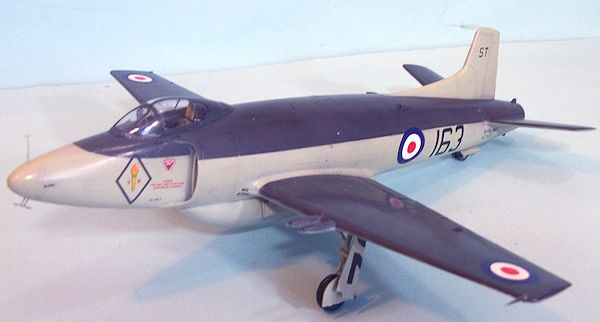 F.Mk.1,
which first appeared May 4, 1950, had no provision for underwing ordnance; No.
800 Squadron FAA was formed with eight Attackers on August 17, 1951, with 803
Squadron following that November. After 43 F.Mk.1s were completed, 16 following
were completed as interim fighter‑bombers under the designation F.B.Mk.1.
F.Mk.1,
which first appeared May 4, 1950, had no provision for underwing ordnance; No.
800 Squadron FAA was formed with eight Attackers on August 17, 1951, with 803
Squadron following that November. After 43 F.Mk.1s were completed, 16 following
were completed as interim fighter‑bombers under the designation F.B.Mk.1.
The definitive
Attacker, the F.B.Mk.2, was powered by a Nene 102, and introduced a metal‑framed
canopy after two failures of the earlier bubble canopy.
This airplane had the same underwing ordnance capability as the Pakistani
Attackers. 84 were delivered, with
the last one produced a few weeks before the Attacker was removed from front
line service.
800
Squadron, with 12 F.B.2s, went aboard the newly‑commissioned HMS "Eagle" on
March 4, 1952. 803 Squadron joined
800 shortly thereafter. After work‑up, the ship departed for the Mediterranean,
with the Attackers finally going to sea operationally. The airplane was already
obsolete, and upon return from the Med, 800 Squadron was disembarked for
disbandment on May 26, 1954. 803
Squadron was returned from Hal Far, Malta, aboard Eagle on June 6, and disbanded
at the end of the month. The
Attacker remained in service with RNVR squadrons until the end of 1956.
While the Attacker did introduce the Fleet Air Arm to jet aircraft operation aboard ship, it had never been brought up to a satisfactory standard. Its altitude performance was poor, it lacked maneuverability, and it was too unstable to be an effective gun platform. As Eric Brown said of it, "the Attacker marked the beginning of the end of the charisma surrounding the Supermarine name."
| THE KIT |
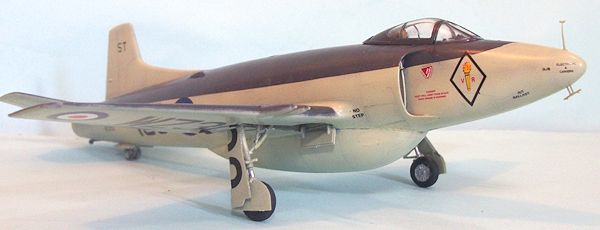 This kit by Trumpeter is the third Supermarine Attacker kit in 1/48, and
the first mainstream injection-molded kit, the other two being a very nice
vacuform from Falcon first released 25 years ago and still available, and the
other being a limited-run kit from Classic Airframes released in 2005 that is no
longer available other than on eBay or from collectors.
This kit by Trumpeter is the third Supermarine Attacker kit in 1/48, and
the first mainstream injection-molded kit, the other two being a very nice
vacuform from Falcon first released 25 years ago and still available, and the
other being a limited-run kit from Classic Airframes released in 2005 that is no
longer available other than on eBay or from collectors.
The kit is developed from the earlier Supermarine Spiteful kit released
last year, and shares the wings and main landing gear with that kit.
It is released as the F.1, which had no facility for underwing ordnance,
though it makes the mistake of not having the F.1 windscreen, with the rounded
clear fairing over the armor glass, being the later modifcation with that
fairing removed. The model can be
built with wings folded, with the modeler having to cut the outer sections free,
but the inner fold parts are included, and with or without the large belly fuel
tank. The decals are really unacceptable, with the underwing serials being too
small, and the side number and carrier identification letter being the wrong
font, as well as the fuselage serial and Royal Navy designator being in the
wrong font. Decals are given for
serial numbers WP493 "J/106" and s/n WA496 "J/101".
According to a quick internet search, "WP493" was a Westland Dragonfly
HR.5, while WP293 was an Attacker F.B.2.
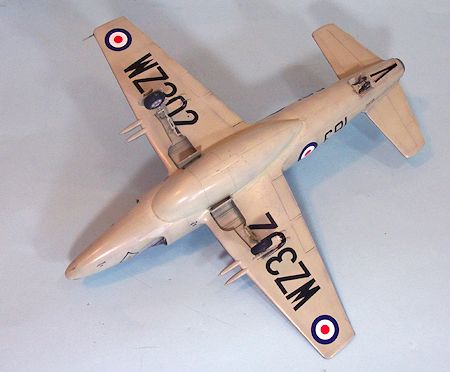 The problems with the decals were such that I stopped work on this
project last October, when I realized the only way to make an acceptable model
was to either piece together markings out of the decal dungeon, or hope an
aftermarket decal company would release a sheet.
I told David Hannant about this problem, and by early January, there was
a release by Xtradecal. This allows
the modeler to do three Royal Navy F.B.2 Attackers (primarily distinguished by
the framed sliding hood, which is easily done with masking, and the flat armor
glass windscreen the kit comes with), as well as three Pakistani Attackers.
The FAA aircraft include one from 800 Squadron aboard HMS Eagle in 1954,
and two from 1831 Squadron, Royal Naval Reserve, basted at Stretton in 1955.
There are additional markings on the sheet to allow a modeler to do the
prototype Spiteful and the first production Spitefuls, RB515/516/518.
This decal sheet is really required to do an acceptable model, and
Hannant’s has already ordered a second printing, demand has been so great.
The problems with the decals were such that I stopped work on this
project last October, when I realized the only way to make an acceptable model
was to either piece together markings out of the decal dungeon, or hope an
aftermarket decal company would release a sheet.
I told David Hannant about this problem, and by early January, there was
a release by Xtradecal. This allows
the modeler to do three Royal Navy F.B.2 Attackers (primarily distinguished by
the framed sliding hood, which is easily done with masking, and the flat armor
glass windscreen the kit comes with), as well as three Pakistani Attackers.
The FAA aircraft include one from 800 Squadron aboard HMS Eagle in 1954,
and two from 1831 Squadron, Royal Naval Reserve, basted at Stretton in 1955.
There are additional markings on the sheet to allow a modeler to do the
prototype Spiteful and the first production Spitefuls, RB515/516/518.
This decal sheet is really required to do an acceptable model, and
Hannant’s has already ordered a second printing, demand has been so great.
| CONSTRUCTION |
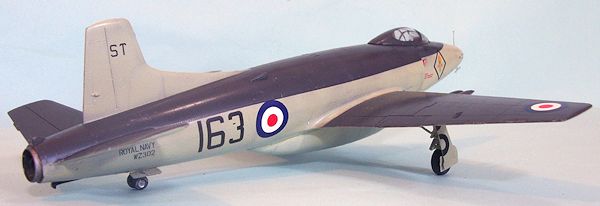 The construction is very straightforward and presents no difficulties.
If care is taken in assembly, there will be no need for any seam filler
anywhere; the only place it will be necessary if you are ham-fisted in assembly
will be along the fuselage centerline.
The construction is very straightforward and presents no difficulties.
If care is taken in assembly, there will be no need for any seam filler
anywhere; the only place it will be necessary if you are ham-fisted in assembly
will be along the fuselage centerline.
The cockpit is pretty basic, but since it will be painted black there
isn’t going to be that much to be seen anyway.
I personally prefer the Attacker with the canopy closed, since the
airframe needs all the help it can get as regards aesthetics.
| COLORS & MARKINGS |
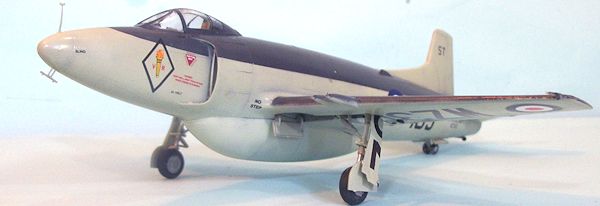 Xtracrylix Gloss clear varnish.
Xtracrylix Gloss clear varnish.
| CONCLUSIONS |
I have always liked the Attacker since I first saw a photo of it in
William Green’s “All The World’s Aircraft, 1954" as a child.
As the only taildragger jet to see service other than the Yak-15, it
presents a very distinctive look among my other 50s jets.
The kit is an easy project and looks good when finished.
February 2013
Review kit courtesy of HobbyLink Japan. Decals courtesy of Hannant’s.
If you would like your product reviewed fairly and fairly quickly, please contact the editor or see other details in the Note to Contributors.